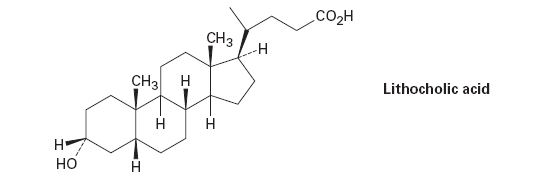
Study Guide with Student Solutions Manual for McMurry's Organic Chemistry, 9th
9th Edition
ISBN: 9781305082144
Author: John E. McMurry
Publisher: Cengage Learning
expand_more
expand_more
format_list_bulleted
Concept explainers
Textbook Question
Chapter 27.6, Problem 9P
Lithocholic acid is an A–B cis steroid found in human bile. Draw lithocholic acid showing chair conformations, as in Figure 27-11, and tell whether the hydroxyl group at C3 is axial or equatorial.

Expert Solution & Answer
Want to see the full answer?
Check out a sample textbook solution
Students have asked these similar questions
How will you prepare the following buffers? 2.5 L of 1.5M buffer, pH = 10.5 from NH4Cl and NH3
CH₂O
and 22
NMR Solvent: CDCl3
IR Solvent: neat
4000
3000
2000
1500
1000
15
[
اند
6,5
9.8
3.0
7.0
6.0
5.0
4.8
3.0
2.0
1.0
9.8
200
100
protons.
Calculate the mass (in grams) of H3AsO4 (MW=141.9416) needed to produce 3.125 x
1026
Chapter 27 Solutions
Study Guide with Student Solutions Manual for McMurry's Organic Chemistry, 9th
Ch. 27.1 - Carnauba wax, used in floor and furniture...Ch. 27.1 - Draw structures of glyceryl tripalmitate and...Ch. 27.2 - Prob. 3PCh. 27.2 - Write the saponication reaction of glyceryl...Ch. 27.4 - Prob. 5PCh. 27.5 - Prob. 6PCh. 27.5 - Prob. 7PCh. 27.6 - Draw the following molecules in chair...Ch. 27.6 - Lithocholic acid is an A–B cis steroid found in...Ch. 27.7 - Prob. 10P
Ch. 27.SE - Prob. 11VCCh. 27.SE - Propose a biosynthetic pathway for the...Ch. 27.SE - Identify the following fatty acid, and tell...Ch. 27.SE - Prob. 14MPCh. 27.SE - Prob. 15MPCh. 27.SE - Prob. 16MPCh. 27.SE - Prob. 17APCh. 27.SE - Fats can be either optically active or optically...Ch. 27.SE - Prob. 19APCh. 27.SE - Show the products you would expect to obtain from...Ch. 27.SE - Draw a Newman projection along the C2-C3 bond of...Ch. 27.SE - The plasmalogens are a group of lipids found in...Ch. 27.SE - Prob. 23APCh. 27.SE - Prob. 24APCh. 27.SE - Prob. 25APCh. 27.SE - Prob. 26APCh. 27.SE - Prob. 27APCh. 27.SE - Prob. 28APCh. 27.SE - Prob. 29APCh. 27.SE - Assume that acetyl CoA containing a 14C isotopic...Ch. 27.SE - Assume that acetyl CoA containing a 14C isotopic...Ch. 27.SE - Assume that acetyl CoA containing a 14C isotopic...Ch. 27.SE - Assume that acetyl CoA containing a 14C isotopic...Ch. 27.SE - Prob. 34APCh. 27.SE - Draw the most stable chair conformation of...Ch. 27.SE - Draw the most stable chair conformation of...Ch. 27.SE - Prob. 37APCh. 27.SE - Prob. 38APCh. 27.SE - Prob. 39APCh. 27.SE - What product would you obtain by reduction of...Ch. 27.SE - Prob. 41APCh. 27.SE - Eleostearic acid, C18H30O2, is a rare fatty acid...Ch. 27.SE - Prob. 43APCh. 27.SE - Prob. 44APCh. 27.SE - Propose a synthesis of diethylstilbestrol (Problem...Ch. 27.SE - Prob. 46APCh. 27.SE - Cembrene, C20H32, is a diterpenoid hydrocarbon...Ch. 27.SE - α-Fenchone is a pleasant-smelling terpenoid...Ch. 27.SE - Prob. 49APCh. 27.SE - Propose a mechanism for the biosynthesis of the...
Additional Science Textbook Solutions
Find more solutions based on key concepts
What process causes the Mediterranean intermediate Water MIW to become more dense than water in the adjacent At...
Applications and Investigations in Earth Science (9th Edition)
Give the IUPAC name for each compound.
Organic Chemistry
1. Rub your hands together vigorously. What happens? Discuss the energy transfers and transformations that take...
College Physics: A Strategic Approach (3rd Edition)
Describe Mendels conclusions about how traits are passed from generation to generation.
Concepts of Genetics (12th Edition)
How does the removal of hydrogen atoms from nutrient molecules result in a loss of energy from the nutrient mol...
SEELEY'S ANATOMY+PHYSIOLOGY
What were the major microbiological interests of Martinus Beijerinck and Sergei Winogradsky? It can be said tha...
Brock Biology of Microorganisms (15th Edition)
Knowledge Booster
Learn more about
Need a deep-dive on the concept behind this application? Look no further. Learn more about this topic, chemistry and related others by exploring similar questions and additional content below.Similar questions
- Using what we have learned in CHEM 2310 and up through class on 1/31, propose a series of reaction steps to achieve the transformation below. Be sure to show all reagents and intermediates for full credit. You do not need to draw mechanism arrows, but you do need to include charges where appropriate. If you do not put your group name, you will get half credit at most. ? Brarrow_forwardDraw a mechanism for the formation of 2-bromovanillin using bromonium ion as the reactive electrophile.arrow_forwardNonearrow_forward
arrow_back_ios
SEE MORE QUESTIONS
arrow_forward_ios
Recommended textbooks for you

 Introduction to General, Organic and BiochemistryChemistryISBN:9781285869759Author:Frederick A. Bettelheim, William H. Brown, Mary K. Campbell, Shawn O. Farrell, Omar TorresPublisher:Cengage Learning
Introduction to General, Organic and BiochemistryChemistryISBN:9781285869759Author:Frederick A. Bettelheim, William H. Brown, Mary K. Campbell, Shawn O. Farrell, Omar TorresPublisher:Cengage Learning Organic ChemistryChemistryISBN:9781305580350Author:William H. Brown, Brent L. Iverson, Eric Anslyn, Christopher S. FootePublisher:Cengage Learning
Organic ChemistryChemistryISBN:9781305580350Author:William H. Brown, Brent L. Iverson, Eric Anslyn, Christopher S. FootePublisher:Cengage Learning


Introduction to General, Organic and Biochemistry
Chemistry
ISBN:9781285869759
Author:Frederick A. Bettelheim, William H. Brown, Mary K. Campbell, Shawn O. Farrell, Omar Torres
Publisher:Cengage Learning

Organic Chemistry
Chemistry
ISBN:9781305580350
Author:William H. Brown, Brent L. Iverson, Eric Anslyn, Christopher S. Foote
Publisher:Cengage Learning
Chapter 4 Alkanes and Cycloalkanes Lesson 2; Author: Linda Hanson;https://www.youtube.com/watch?v=AL_CM_Btef4;License: Standard YouTube License, CC-BY
Chapter 4 Alkanes and Cycloalkanes Lesson 1; Author: Linda Hanson;https://www.youtube.com/watch?v=PPIa6EHJMJw;License: Standard Youtube License